| Lista Light |  |
Saba
The road bridge was drawn and the mighty mega yachts elbowed their way pass us in the queue as we all left the Simpson Bay Lagoon and departed for the ocean. Brown, Ella, Cadence and Jenna held a banner up to us by the bridge and we shouted goodbyes to them and a great Caribbean chapter of our lives. We didn’t actually get that far, just out of the lagoon before the never-ending ‘stowing’ ensued. Finally sails a-blazing we blasted over the waves for Saba, a shattered, variously queasy motley crew. We did not see many birds on the crossing, nor have we in general when moving between islands. The most notably absence, however, have been cetaceans – not a single whale or dolphin has been spotted since we arrived in the Caribbean. The contrast is dramatic when compared with the waters of: Wales, Scotland, West Ireland, the Bay of Biscay, the Spanish and Portuguese coastline and the Atlantic- pretty much everywhere we have been so far!
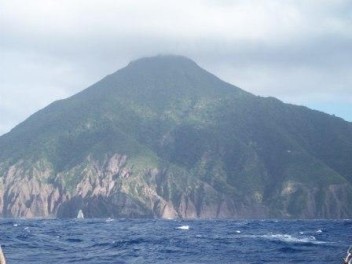
Saba was about as removed from the hustle and glitz of Sint Maarten as was possible; a towering, green, mountainous island rose from the sea to greet us. A helter-skelter of roads coiled up the sides of the extinct volcano and lead one to ‘The Bottom’, ‘Hells’ Gate’, ‘The Gap’, ‘Windwardside’ and other such self-explanatory place names. Apparently they have a triathlon in December, very tempting, but at present state of fitness I expect Dave and I would be crawling at the back- the hills were tortuous.
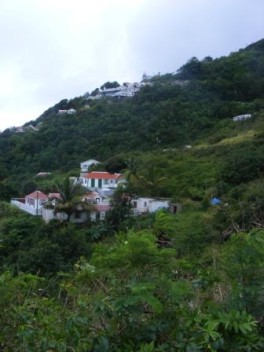
The houses were picturesque, quaint, perhaps kitsch, nestled on the side of the island with orange pan tiles or corrugated roofs, adding a timeless air to the island. Natalia, Megan and I began bird surveys recording the number of flying Red-billed Tropic Birds from the boat and at various locations around the island. Tropic Birds are stunning, so exotic to my British eyes, with their white steaming tails billowing behind them and squawking aerial flight. Better still, we found that the best time for observing them was a very civilized 3.30pm survey time slot... a sweet treat from my days of rising at 4.00am to clamber mole-eyed over a howling mountain top.
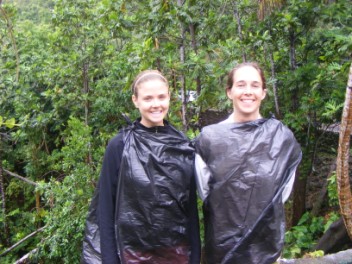
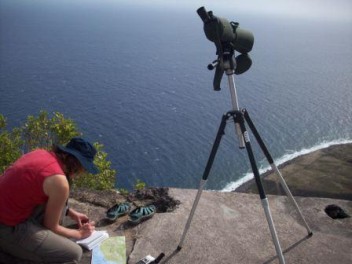
But perhaps the Queen of seabirds and also the crowned King of Saba as the national bird, was the Audubon’s Shearwater (locally known as the Wedrego). After checking out potential nesting habitat we returned late in the evening and played Shearwater duets to attract a reply from rival males. The cackling call echoed from the mega-blaster around the wooded hillside and then suddenly a response from the dark and a grey image flittered over our heads. For the next half an hour, various birds responded to us from the darkness and we able to confirm that the Wedrego was nesting and estimated how many there were.
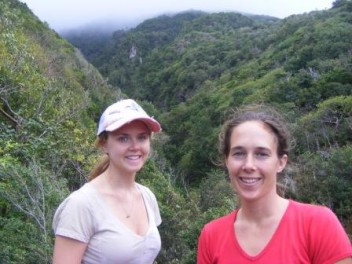
As we wondered back up the hillside to the waiting taxi, land crabs waved their pincers at us in the glimmer of our torches, a miniature scorpion scuttled across the path and a huge black moth (the size of a small bat) flittered passed. We were enchanted with the Shearwater and its environment. Saba possessed much more of the wild Caribbean that we had been yearning for.
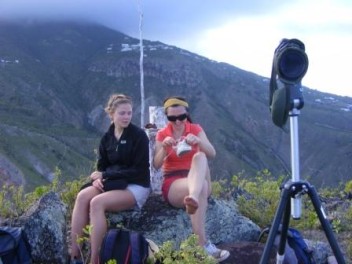
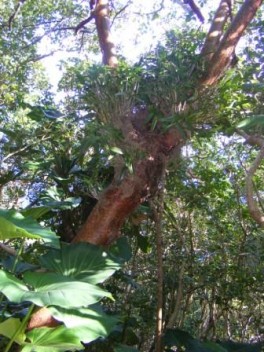
The next morning more Tropic Bird aerial counts ensued and nest searching, with all five of us scrambling up the crumbling slopes of the bay. Dave was first to smell a nest- the stench of guano is over-powering, but the sight of a ruby-red beak, velvet eyes and zebra-striped feathers peering menacingly out at us from a boulder had us all (as a friend of mine would say) melting. The scrawny chicks with their crown of pin feathers caused similar exclamations.
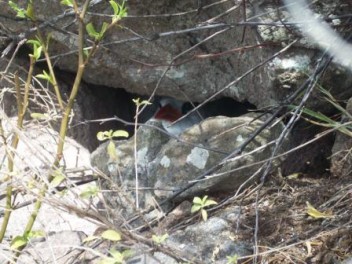
Over the next couple of days we scrambled around most of the perimeter of the island looking for breeding seabirds, paying particular attention to the prime Tropic Bird locations pointed out to us by the islanders. We also presented to a group of school children and to interested locals about the project. A couple we met at the presentation (Paul and Sue ) were very familiar with the Wedrego hearing it each night from their house. Thus one evening, amid Sabin Lemon Tart, fine chat and snuggled under a blanket, we listened to the call of the Wedrego echoing over the hillside.
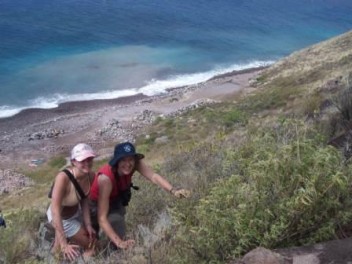
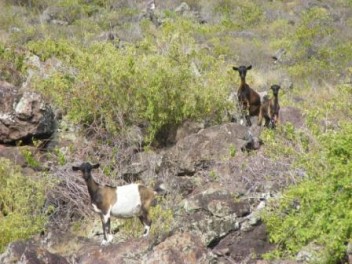
Another highlight was the North Coast Trail. Contrary to our adventurous spirit we were obliged to take a guide due to a pack of feral dogs fabled to lurk in those wild Saban recesses. The guide, ‘Crocodile James’ was great and full of stories, fables and survival skills. He showed us crumbling ruins, leaves smelling of cinnamon that could be brewed and a charcoal pit that he and other islanders had built in an effort to re-establish island traditions. Our fellow walkers, however, were of an all together different breed! I had never imagined that putting one foot in front of another could be considered technical?! Apparently so!
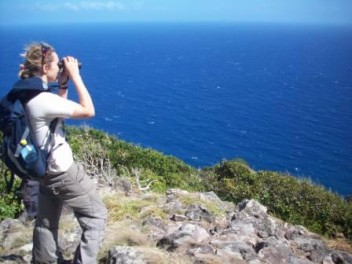
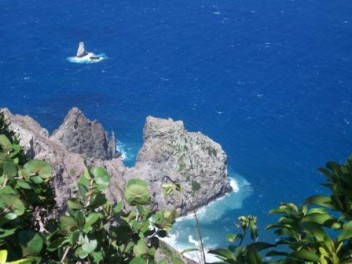
During our stay we had changed anchorage to a sturdier buoy, but the wind continued to blow and the swell mounted. Lista rocked wildly from side to side. (Jenna, who had come to visit for the weekend, turned green as soon as she stepped aboard and remained above deck for her stay.) Dave added a further line to the huge buoy we were attached to in attempt to keep us secure. On the last day, he came to collect Megan, Jenna and I, leaving Emily to man the boat with instructions of what to do should the lines snap. He was concerned and hurried us onto the dinghy. Can you believe it, as the wee engine ‘putputted’ through the crashing waves, Lista broke free.
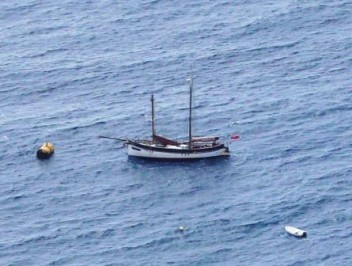
Luckily, Emily had emerged from below decks and we shouted instruction to her as Lista drifted further away from us. It was a horrid feeling watching our home- our friend, Lista, apparently deciding to depart of her own accord. As for poor Emily, she looked tiny at Lista’s helm, dwarfed by her 50ft length, but she managed to turn List around and we finally caught up with her and clung to her sides. It was a nasty initiation into the world of boats and the sea for Emily and another reminder to me of the wild forces we are dealing with.
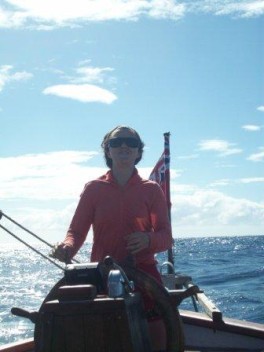
The longer we inhabit this salty, aqueous environment, the more I fear, respect and love it. Man has conquered space, suppressed forest and valley, but still cannot tame the mountains or the sea. People and goods are transported along the world’s invisible sea lanes, but should the waves and winds transpire against them, their steel and might are pathetic against such monstrous forces. I think this is extremely humbling in a world where humans feel they have no bounds, systematically destroying and manipulating habitats and species whilst pumping noxious gases into the air and pollutants into the land and sea. It is amazing thinking of the world that lies often kilometres below Lista, packed with multi-coloured, generally fiendish-looking species, most of which man has no knowledge of.
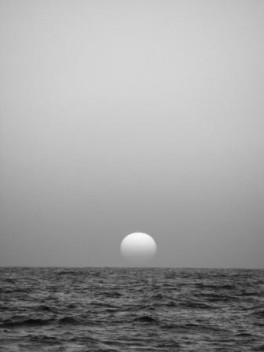
During the Atlantic crossing, all the crew read ‘Voyage of a Madman’ by .. given to us by Clare (Emily and Megan are the latest addicts). An incredible read, it charts the first non-stop solo circumnavigation in 1968 (just after man had walked on the moon). It had all of us gripped, wolfing it down during the dark hours between shifts. After spending over six months on our floating island we were able to empathise with many of the sentiments experienced, but the over-riding feeling was of awe, of sailors who had ventured around the world completely alone, navigating by the stars and sun, living through some of the most hostile conditions on earth amid the roaring forties. Unable to communicate with home, there only option was to get close enough to the potentially fatal bulk of a ship and catapult a message aboard to let all at home know that they were safe.
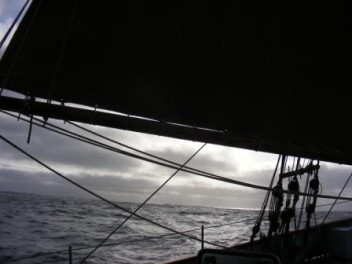
As yachts cross the Atlantic in a seemingly endless caravan of smart, modern, boats, with GPS and ‘sat’ phones, the life of a sailor seems tamed, but should the ocean choose to awake, little has changed from when man first took to the sea in the great fight of ‘Sailor versus Neptune’. We have also been reading Steven Callahan’s, ‘Adrift’, another excellent read. It chronicles the author’s fateful journey on a life raft across the Atlantic after his boat sank into the deep. The reason I brought these books up is that they emphasise how insignificant man still is. We are ever respectful of our salty home and as we dive below Lista’s hulk we appreciate what a tiny speck we are in the blue ‘desert’ of the sea.
Back to previous section - Sint Maarten
Forward to next section - St Eustatia
This page hit Count : 4710
This is the Lista Light Website, for the travels of the sailing boat Lista Light
Click here for text-version of site